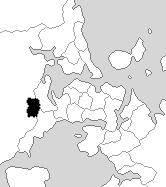
Henderson is a future parliamentary electorate in the next New Zealand general election. [1] The electorate was in use from 1969 to 1978 and then from 1993 to 1996, and now from 2026 onwards.

Henderson is a future parliamentary electorate in the next New Zealand general election. [1] The electorate was in use from 1969 to 1978 and then from 1993 to 1996, and now from 2026 onwards.
Henderson was first created through the 1967 electoral redistribution, which resulted from the Electoral Act 1965 that fixed the number of South Island electorates at 25. As a result, three additional electorates were created in the North Island, and one additional in the South Island. One of those new electorates was Henderson, which took over most of Waitakere's area. These changes came into effect with the 1969 election. [2] Localities that were covered by the electorate include Henderson, Oratia, Waiatarua, Parau, Huia, and Piha. [3] In the 1972 electoral redistribution, there were slight boundary adjustments with the adjoining Waitemata and New Lynn electorates. [4] Henderson existed for three electoral cycles and was abolished again through the 1977 electoral redistribution, when Waitakere was recreated; this came into effect with the 1978 election. [5]
Henderson was recreated for the 1993 election and existed for one parliamentary term. In 1996, the first mixed-member proportional (MMP) election, the area was absorbed into the new Waipareira electorate.
Henderson was recreated for the next election in the 2025 Boundary Review as part of a wider re-configuration of the West Auckland electorates. [6] The re-created electorate includes the West Auckland communities of Henderson, Henderson Valley, Lincoln, Rānui and Swanson.

Martyn Finlay of the Labour Party had been Waitakere's representative since the 1963 election. He transferred to the Henderson electorate and was successful against three different National Party opponents in 1969, 1972, and 1975. When Henderson was abolished for 1978 election, Finlay went into retirement. [7]
Key
| Election | Winner | |
|---|---|---|
| 1969 election | Martyn Finlay | |
| 1972 election | ||
| 1975 election | ||
| (Electorate abolished 1978–1993, see Waitakere) | ||
| 1993 election | Jack Elder | |
| (Electorate abolished 1996, see Waipareira) | ||
| Party | Candidate | Votes | % | ±% | |
|---|---|---|---|---|---|
| Labour | Jack Elder | 6,381 | 39.81 | ||
| National | David Jorgensen | 4,251 | 26.52 | ||
| Alliance | Alistair Paterson | 3,378 | 21.07 | ||
| NZ First | Arthur Albert | 1,120 | 6.98 | ||
| Christian Heritage | Clive Thompson | 618 | 3.85 | ||
| McGillicuddy Serious | Doug Mackie | 106 | 0.66 | ||
| Workers Rights | Sue Bradford | 95 | 0.59 | ||
| Independent | Grant Philpott | 53 | 0.33 | ||
| Independent | Victor Bryers | 23 | 0.14 | ||
| Majority | 2,130 | 13.29 | |||
| Turnout | 16,025 | 80.73 | |||
| Registered electors | 19,850 | ||||
| Party | Candidate | Votes | % | ±% | |
|---|---|---|---|---|---|
| Labour | Martyn Finlay | 7,665 | 43.16 | −17.05 | |
| National | Warren Adams | 7,264 | 40.90 | ||
| Social Credit | Wendy Glamuzina | 1,572 | 8.85 | ||
| Values | Julie Mowat | 1,222 | 6.88 | ||
| Socialist Unity | Jim Thomson | 35 | 0.19 | ||
| Majority | 401 | 2.25 | −27.87 | ||
| Turnout | 17,758 | 80.84 | −5.03 | ||
| Registered electors | 21,966 | ||||
| Party | Candidate | Votes | % | ±% | |
|---|---|---|---|---|---|
| Labour | Martyn Finlay | 8,438 | 60.21 | +4.14 | |
| National | Ross C. MacFarlane | 4,217 | 30.09 | ||
| Social Credit | Wayne Brodeur | 1,240 | 8.84 | ||
| New Democratic | Len Inkster | 117 | 0.83 | ||
| Majority | 4,221 | 30.12 | +8.73 | ||
| Turnout | 14,012 | 85.87 | −4.14 | ||
| Registered electors | 16,316 | ||||
| Party | Candidate | Votes | % | ±% | |
|---|---|---|---|---|---|
| Labour | Martyn Finlay | 8,635 | 56.07 | ||
| National | Adrian Clarke | 5,340 | 34.67 | ||
| Social Credit | William Edward Rossiter | 1,204 | 7.81 | ||
| Independent | Marianne Simpkins | 219 | 1.42 | ||
| Majority | 3,295 | 21.39 | |||
| Turnout | 15,398 | 90.01 | |||
| Registered electors | 17,106 | ||||